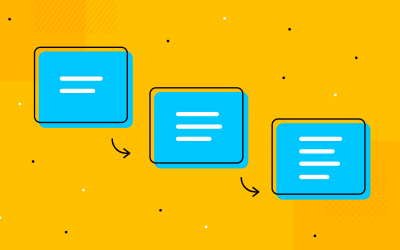App-only Atom Bank is changing banking as we know it. How? With imagination, innovation and very savvy prototyping. Head of UX Nick Wiles explains
The way we manage our money is changing. Where once the experience of banking was in-person, paper-driven and impersonal, it is now personalized, immediate and, increasingly, entirely digital. The user experience revolution has up-ended our accounts for the better.
App-only challenger Atom Bank is one of the young turks making waves in consumer banking. Although it only officially opened its doors in 2016, the UK outfit now has more than 250 employees and deposits of over $130 million. Atom Bank has also gained plaudits for user-centricity and design innovation, with rumours of gamification and 3-D visualizations adding to the hype.
Nick Wiles, the bank’s Head of User Experience, is intent on doing things differently at Atom Bank. Justinmind sat down with Nick to find out about how his UX team stay creative, and Atom’s plans to revolutionize the way we bank.
Justinmind readers might not have heard of Atom Bank. Can you explain more about the bank and what makes it different?
The primary difference is that Atom is app-only. We don’t have a branch network, we don’t offer our retail banking services over a website, we only offer them through an app. We feel this is more secure because there’s point-to-point access between you and your app.
You can’t just log into any browser and input some passwords to access accounts: it has to be your device, with your app on it to access your Atom accounts.
Another thing that sets us apart is our determination to ensure that we’re eventually hooked into the whole mobile OS sub-structure, to take advantage of the whole device. We don’t just think about the screen as the complete experience, instead we think about the whole device and how that can help us to provide a better service for customers.
Most banking apps just focus on visuals; there seems to be very little done with all the other sensors the device has. There’s a Bluetooth transmitter, there’s a Wi-Fi transmitter and receiver, there’s location detection. There are all kinds of things you can tap into.
If you take that perspective, the IoT and the fact your device knows where you are, provides us with some interesting opportunities to create a unique customer experience, and a way to redefine customers’ relationship with their money.
How is the UX/Design team at Atom organized, and what do you and your team spend your days working on?
We’ve got a classic app development set up (if anything’s classic these days!) Ultimately it all comes back to iterative design. We have a design team and we have a product & propositions team, and then we’ve got the banking specialists – they are responsible for working out the product from a banking perspective.
UX sits in the design, brand and marketing team. We’re responsible for designing the presentation layer, the UI and the user experience of Atom. We interface with the app development team, who are responsible for developing the technology and hooking that into the banking systems via middleware.
The BAs and the Solutions Architects gather requirements, we take those requirements and turn them into an Atom Customer Experience and illustrate and visualize those requirements. Then we get those customer flows signed off from a compliance and legal perspective as well as from a brand experience perspective, and then we work with the developers to build that into a proper app.
All of that’s done iteratively: we’re constantly experimenting with the way our workflow functions to try to get the best out of the small number of people we’ve got on site. We’re just 280 people for a full retail banking proposition, compared to the 1000s of people in the big blue-chips.
Can you tell us where prototyping fits into the design and development process at Atom?
We prototype fit for purpose or application. Depending on what we want to do we’ll take a prototype on a couple of scraps of paper, on screenshots, or using XD out of the Adobe Suite. We’ll create a click-through prototype based on that.
If we’re just at the stage of “we’ve got the idea for a flow”, we might sketch that out on a whiteboard. When we’ve got reasonable buy-in we might transfer into some sort of black and white prototype in XD, and if that works then we can start to layer on transitional pieces and everything else.
Before long we can get it to proper code and spin up Beta versions, and test those out on a wider audience. Depending on the phase of a deliverable, we’ll adopt the relevant prototyping tool for that situation.
At what point do you add user testing?
We’ve been testing on real people since day one. To begin with we took advantage of our immediate audience and new people entering the business. We used weekly guerilla testing to get the ideas out of the design department, and we rapidly started using our call center people who have direct contact with our customer base, and then utilized real customers.
More recently we’ve started to use Userzoom, and we’re going to be doing more remote usability testing using that product, which will allow us to push prototypes out to a panel that we’re recruiting. That panel will potentially get a drop on Friday night and we’ll expect some feedback from them as early on Monday; we can start acting on that feedback in the prototype.
Userzoom is quite flexible in that respect because we can push various levels of fidelity out via that system and get feedback on customers using it.
What’s the average Atom user like? One would assume that the average user is young, a millennial?
Well no actually. It’s an attitude rather than an age. We’re looking for people that want something different, that are open to trying something new. The millennial fits that type, but it can be a millennial of any age, and that’s where the attitude comes in. Our age range is huge.
Mobile banking apps have been criticized as being much of a muchness, and a low quality muchness at that. How can banking UX teams stay innovative without compromising functionality?
I like this question! You’re right, traditional banks are delivering an ability to look at your money online, look at electronic statements, manage a few transactions and see your account details. I think the only way you can think about this more innovatively is if you reimagine the why’s, the how’s, the who’s, the where’s, and the when’s.
Reimagining why people want to access their banking information on a mobile device. Why would they want to do it? And who are these people? Are they the classic banking customer or are they youngster opening their first bank account because they’ve got their first mobile phone, or a child account that their parents have set them up with?
And then there’s the what – what do people want a bank on their phone for? Are they still following the same banking patterns or are they more likely to do it in a different way? Do they want notifications?
How are people using their bank? Are they still logging in to do it, or are they going to use Alexa do it for them? Is the bank their using going to let Siri access their information without them logging in, assuming they’re in a safe environment based on the ‘where’? What could we do based on location that allows customers to stop worrying about security?
It’s no longer about enabling customers to just look at a bank statement; it’s about making the experience relevant to what they’re doing, and providing them the information whenever and wherever they need it.
Is there a particular feature in the app that captures the USP of Atom for you?
Perhaps the concept of understanding at a glance where your mortgage is in the application process. We’ve got a timeline function in the app that’s allows you to see your application process in its various stages and we provide updates to let you know how it’s going. I think that hits the mark as to how we’re doing things differently.
What’s different about working at Atom to the large established banks with legacy systems you worked in before?
The one thing that comes to mind is the fact that they have legacy systems and they’ve become large, and it takes a long time to change direction or velocity. There a lot of good noise in the Fintech environment about banks becoming much more agile, as in easier to change direction. I don’t see any reason why the big players can’t do that and indeed there’s evidence of that happening.
The advantage Atom has at the moment is that we’ve assembled our systems from the ground up using components and partners selected for a specific reasons, or built them ourselves, and we were always striving to make the systems as agile as possible. We did it this way so if something doesn’t work we can change it, and change quickly.
I think of agility in this context as the ability of an organization to be more fleet of foot and because of the way customers are going at the minute they’re looking for a faster turnaround, I think it’ll pay dividends.
The last thing I’m intending to do is create something that’s the same as the others. I’ve done that before. It’s about time that people started thinking about the devices they have, the control they have to access their accounts and see what their money’s doing and see what their life is doing.
Related Content
 Microcopy may be mini, but it can have a macro impact on user experience. Check out these 15 examples and start writing great UX microcopy16 min Read
Microcopy may be mini, but it can have a macro impact on user experience. Check out these 15 examples and start writing great UX microcopy16 min Read UX design has changed all of our lives forever - but what does it entail, exactly? What do designers do to create incredible products? Read on and find out!15 min Read
UX design has changed all of our lives forever - but what does it entail, exactly? What do designers do to create incredible products? Read on and find out!15 min Read Progressive disclosure is about helping users get invested before getting to the nitty gritty. Read this post to discover a new way to approach complex features!8 min Read
Progressive disclosure is about helping users get invested before getting to the nitty gritty. Read this post to discover a new way to approach complex features!8 min Read



